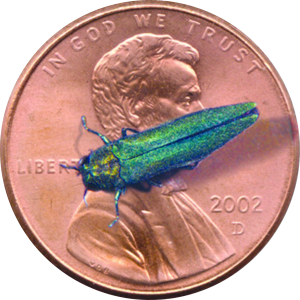What’s shiny and Godzilla green, easily fits on a penny, and has resulted in the death of tens of millions of trees over the past dozen years? If you’ve been paying attention to this blog, you might guess the emerald ash borer (EAB). Over the past few years my colleagues and I have been involved with a monitoring project designed to detect the first EAB entering north Texas. During this time I’ve watched the beetles inch closer to Texas–moving from its initial point of invasion in Michigan throughout the Ohio River valley and eventually into Missouri, Kansas and Colorado, and, last summer, in six counties in southern Arkansas.
Earlier this month, on a hunch, some zealous U.S. Forest Service employees examined a likely ash stand of 12-15 trees outside of Pineville, LA. On Feb 10, entomologist James Zablotny, emerald ash borer identification specialist for USDA, APHIS, PPQ in Romulus, Michigan, confirmed that three larvae collected from the trees were indeed EAB. The collection site was just inside the Louisiana border, about 9 miles east of Springhill, LA, in Webster Parish.
These latest finds put the EAB within 40 miles of Texas, and suggest that we in Texas may be next, if the beetle isn’t here already.
So how is this beetle with stubby wings getting so close so fast? With the help of man, no doubt. Experts believe that the most common way that this beetle finds its way across state lines is in firewood. Campers, sportsmen, or firewood vendors cut up borer-infested trees and put them on a vehicle and give the hitchhiking insects a lift.

Emerald ash borer larva and damage under the bark of white fringetree, a new host of this pest. Image from D. Cipollini, J of Economic Entomology, Feb 2015.
What does this mean to owners of ash trees? Since the nearest infestations are approximately 40 miles away from our state, nothing yet. However, experience from other states suggests that owners of valuable ash trees within 15 miles of a known infestation should consider proactive treatment of their trees with a labeled insecticide.
In a few weeks our office, along with entomologists from the Texas Forest Service and Sam Houston State University, will start the 2015 Texas EAB survey. This is something we’ve been doing for over five years, but this year takes on extra meaning with the threat known so close to our border.
More bad news
As if we needed more bad news, in addition to ash (trees in the genus Fraxinus), the EAB has now been found to attack white fringe tree, Chionanthus virginicus, a native tree species that is also used sometimes as an ornamental plant. In an article published in the Journal of Economic Entomology this month, Dr. Don Cipollini of Wright State University in Ohio presented the first evidence that EAB might attack other plants in addition to ash. Although fringetree is a relative of ash, the possibility exists that a few other, native plant genera closely related to Chionanthus might be susceptible to this pest.
While maybe not as destructive as Godzilla, I have no doubt we will learn to respect this pest. More on symptoms and different management options in later posts.

